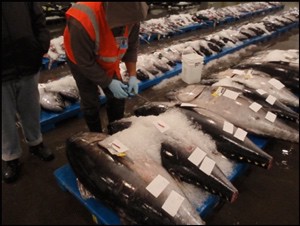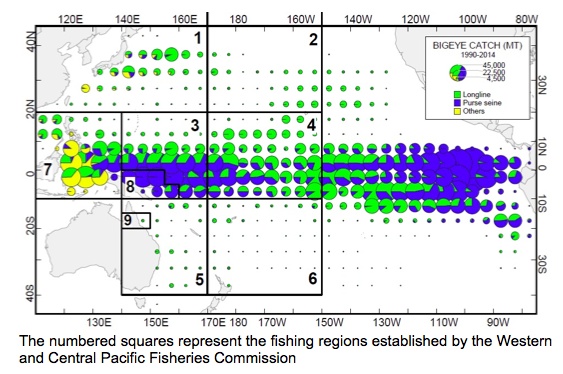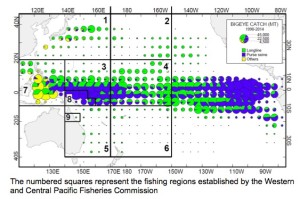Editor’s note: On November 30, the National Marine Fisheries Service announced that it had approved an agreement between the Hawai`i Longline Association and Guam that cleared the way for charging Hawai`i longliners’ bigeye tuna catch against the Guam quota allocation, effective November 27.
This year, the 144 longline vessels based in Honolulu raced through their annual catch quota for bigeye tuna established by the international commission regulating fisheries in the Western and Central Pacific Ocean. By August, they had caught most of the 3,502 metric tons that they were limited to for 2015.

In August, the National Marine Fisheries Service shut the fishery down. Most vessels (all but the largest in the fleet) could continue to fish for bigeye in the Eastern Pacific, but the fishing grounds there were more distant and, at that time of the year, weather was unsettled; there were, after all, a record number of named tropical storms in the Eastern Pacific this year. In addition, some vessels that hold federal fishing permits allowing them to fish in Hawai`i and American Samoa could continue to operate and deliver fish to the Honolulu auction house.
The shut-down lasted until October 9, when NMFS announced that the Commonwealth of the Northern Mariana Islands, a U.S. territory, could sell up to half of its 2,000-metric-ton bigeye quota to those Hawai`i vessels that were members of the Hawai`i Longline Association. The HLA had entered into an agreement in 2014 with the CNMI that allowed this purchase, satisfying one of the terms of the quota assignment set by a recent amendment to the federal fishery management plan for tuna in the Western Pacific.
Over the next few weeks, the Honolulu longline fleet once again began to land bigeye at a record-setting pace – the same pace that had allowed the boats to eat through their quota by August.
On November 27, NMFS announced that the CNMI quota allocation of 1,000 metric tons would be reached by November 30. After that, all bigeye caught will be charged against a second territorial quota – that of Guam.
Guam Saves the Day
On November 6, NMFS published a final rule that sets the 2015 bigeye quota for the U.S. territory of Guam at 2,000 metric tons, half of which could be assigned to the Honolulu longliners.
Before the Guam quota can be transferred, however, the government of Guam and the HLA – through its subsidiary, Quota Management, Inc. – need to agree on terms, including how much HLA will pay for the fishing rights. Then agreement then must be submitted to the Pacific Islands Regional Office of NMFS for its approval.
As of late November, this had not been done.
Mike Tosatto, PIRO administrator, told Environment Hawai`i, “We know that HLA and Guam are talking, but I have not seen any agreement yet.”
David Henkin, the Earthjustice attorney for environmental groups challenging NMFS in federal court over the quota-shifting arrangement, notified Judge Leslie E. Kobayashi of the development:
“The specifications [in the new rule] are expressly designed to allow Hawai`i-based longliners to continue to catch bigeye tuna, without interruption, after they exhaust the current, 1,000-metric-ton allocation agreement with … CNMI,” Henkin wrote. The new rule as well as the earlier one for the CNMI “purport to allow the Hawai`i-based longline fleet to circumvent the 2015 bigeye catch limit for U.S.-flagged longline vessels established by the Western and Central Pacific Fisheries Commission.”
(Kobayashi heard arguments on the lawsuit in late September. As of press time, she had not issued a ruling in the case.)
And if the Guam quota doesn’t hold till the end of the year? Well, there’s always American Samoa – provided the federal court upholds the quota-shifting arrangement.
* * *
Spatial Quotas?
At the October meeting of the Western Pacific Fishery Management Council in American Samoa, a good part of the discussion focused on a concept that could change the way bigeye quotas are established.
Bigeye Tuna Catches in the Pacific Ocean, 1990-2014
A map of bigeye catches across the Pacific Ocean reveals that the areas visited by the Honolulu longliners are lightly fished in comparison to other regions. Wespaac staffer Eric Kingma suggested that the fishing effort in these regions could be increased could be increased substantially without damaging the prospects for recovery of Pacific bigeye stocks.
“It’s well established that even without the U.S. fishery, if we took that off the table, it wouldn’t have any impact on bigeye overfishing,” Kingma told the council.
“The take-home message here is, basically, even with the Hawai`i longline fishery combined with territory transfers in each year – even if you’re catching 7,000 metric tons in total, there is still a less than 1 percent change to the baseline status stock reference points… Even with the transfers, it’s not impeding international conservation objectives to achieve or eliminate bigeye overfishing in combination with the measures adopted by the Western and Central Fisheries Commission.”
Those measures, he went on to say, are working. The SPC – Secretariat of the Pacific Community, which monitors fisheries in the region – “has evaluated the current Conservation and Management Measure” for bigeye, Kingma said, “and the measure is working…. In the future, the measure is expected to have an effect by 2032 so we’re no longer in an overfishing condition.”
Of course, he continued, “that depends on a few things: that countries will fully implement the measure and recruitment is maintained. All indications are that this is likely to occur as well. So the measure is working. We’re meeting conservation objectives.”
(The SPC’s evaluation, released last month, indeed projected that under its most optimistic scenario for the CMM, overfishing would, in fact, end well before 2032. The organization noted that the longline sector’s 2014 catches were generally in line with the optimistic scenario, in which commission members chose the more conservative fishing limits allowed under the CMM. However, the SPC added, “This is qualified by the fact that: there are [commission members] whose fleets have no limit within the measure, and whose bigeye catches have increased since 2012; and that while we are working with the latest 2014 longline data, … bigeye longline catch data for the most recent years tends to be revised upward over time.” What’s more, the organization noted that the number of sets on fish aggregating devices by purse seiners did not “appear to be ‘on track’” with the optimistic scenario.)
In the area fished by the Hawai`i vessels, Kingma stated, “there is very little difference between spawning stock biomass” – a measure of the ability of the fish to reproduce – “and virgin biomass” – the abundance of the stock before it was subject to fishing. Throughout the Western and Central Pacific, he said, “spawning stock biomass is estimated around 20 percent of pre-fishing biomass, so it’s not as though the fishery is falling off the cliff.”
Keith Bigelow, a fisheries biologist with the Pacific Islands Fisheries Science Center, a research arm of NMFS, provided further details on the way in which bigeye tuna in the regions fished by the Hawai`i vessels could be “spatially disaggregated” from the rest of the Western Pacific. This, he suggested, could be used in developing a proposal for consideration by the WCPFC at its December meeting.
“The conceptual idea is to have exploitation be in proportion to subregional abundance,” Bigelow said.
Charles Daxboeck, who chairs the council’s Scientific and Statistical Committee, reported that the SSC “would like to see the WCPFC stock assessment regions be quota-apportioned according to stock estimates within each region, as opposed to an overall quota system.” This, he continued, “would be more equitable, based on the fact that our fishery has a limited impact in the tropical zone.”
The full council approved a recommendation to the National Marine Fisheries Service that it develop the spatial management idea into a formal proposal for WCPFC.
— Patricia Tummons



Leave a Reply